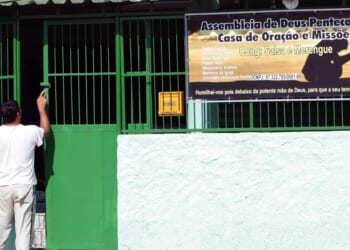
By José Niño
William Trevor Case was shot in his own home by police officers when they entered without a warrant. Now the Supreme Court must decide whether that entry was constitutional, and the answer could reshape when officers can enter people’s homes uninvited.
Click the Link Below to Listen to the Audio of this Article
The justices heard oral arguments on Oct. 15 in Case v. Montana, a dispute that forces the high court to confront what “emergency” actually means when police believe someone inside a home needs help. The Montana Supreme Court ruled that officers need only “reasonable suspicion” to enter during welfare checks, a standard so permissive that Justice Sonia Sotomayor noted it seemed “less intrusive than a Terry stop”—a brief, temporary detention of an individual by a law enforcement officer who alleges he has “reasonable suspicion” that the person is involved in criminal activity. Fred A. Rowley Jr., representing Case, argue they need probable cause. The justices appeared dissatisfied with both positions.
The events began on Sept. 27, 2021, when City of Anaconda police received a call from Case’s ex-girlfriend. She reported that the U.S. Army veteran had threatened suicide, mentioned having a loaded firearm, and that she heard a “pop” during their call. She warned he would harm any officers who came to his residence. Police knew Case from prior encounters, including what they believed was an attempt at “suicide by cop.”
Officers arrived at his home and knocked repeatedly, shouting through an open window. No one answered. Peering through windows, they saw empty beer cans, an empty gun holster, and what appeared to be a suicide note. After waiting approximately 40 minutes, they entered without obtaining a warrant.
Moving through the house with weapons drawn and loudly announcing their presence, officers eventually encountered Case emerging from behind a closet curtain in an upstairs bedroom. One officer, believing he saw a dark object or gun near Case’s waist, shot him in the abdomen. A handgun was later discovered in a laundry hamper near where Case fell.
Montana prosecutors charged Case with felony assault on a peace officer. Case moved to suppress the gun and other evidence, arguing the warrantless entry violated his Fourth Amendment rights. The trial court denied the motion. A jury convicted him.
The Montana Supreme Court upheld that conviction in a 4-3 decision in August 2024, applying the “community caretaker doctrine” and requiring only “reasonable suspicion” for warrantless welfare check entries. The Supreme Court granted certiorari on June 2, 2025.
A notable coalition of civil liberties advocates assembled to support Case’s position—that probable cause should be required. The National Association of Criminal Defense Lawyers argued that lowering the standard “invites pretextual or post hoc justifications, increases risks of violent confrontations, and undermines privacy.” The American Civil Liberties Union emphasized that the Fourth Amendment protects the home as “first among equals.”
The Constitutional Accountability Center offered a striking historical argument. They contended that “founding-era” common law required more than probable cause, not less, for warrantless home entries. The common law regarded a person’s home as his castle, allowing warrantless entry only in three narrowly defined scenarios, all requiring more than probable cause. The Cato Institute, Americans for Prosperity Foundation, and several other organizations filed briefs supporting Case.
Montana Solicitor General Christian B. Corrigan defended the state’s actions with support from the Trump administration’s Department of Justice. The federal government argued for a “sliding scale” approach where requirements vary based on the severity of danger, contending that founding era common law recognized a “robust necessity doctrine” allowing property rights to give way when life and limb were at stake.
Michigan and other states supported Montana’s position.
At oral arguments, Sotomayor questioned Montana’s permissive standard, while Justice Samuel Alito questioned whether police could ever enter to prevent self-harm under Case’s proposed probable cause requirement. Justice Ketanji Brown Jackson countered sharply, emphasizing officers’ body camera statements that Case “doesn’t have the guts” and likely sought “suicide by cop,” suggesting the officers themselves didn’t believe the emergency was imminent.
Rowley stressed that “this court has never allowed state officials to force their way into someone’s home without a warrant or probable cause. It should not start now.” Corrigan warned that “a rule demanding probable cause of peril would force officers to stand outside a dying man’s door, calculating legal thresholds instead of saving his life.”
A decision is expected between April and June 2026. The stakes extend far beyond one man’s conviction. The decision will determine the constitutional boundaries for approximately 10% to 20% of all police calls that involve welfare checks and mental health crises.
As Constitutional Accountability Center Deputy Chief Counsel Brian Frazelle observed following oral arguments, the eventual ruling may authorize more expansive police authority than Fourth Amendment originalists would prefer.




















